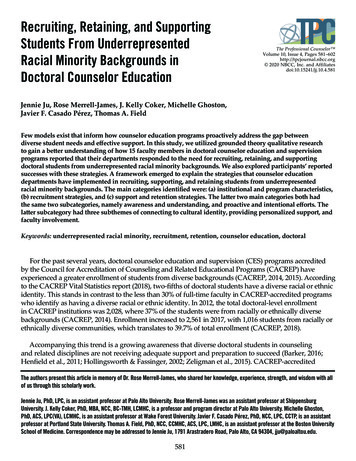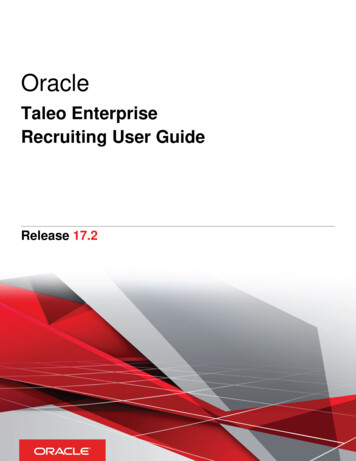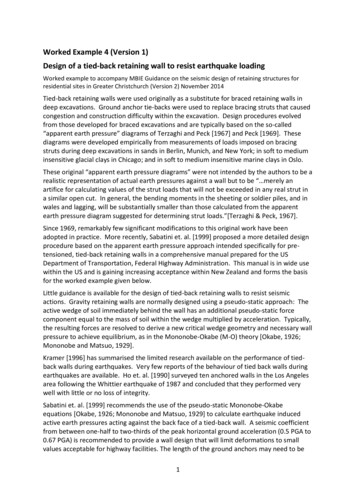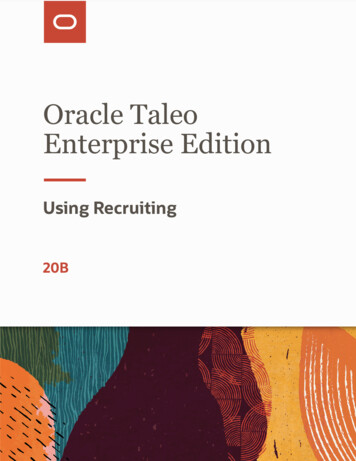
Transcription
Recruiting, Retaining, and SupportingStudents From UnderrepresentedRacial Minority Backgrounds inDoctoral Counselor EducationThe Professional Counselor Volume 10, Issue 4, Pages 581–602http://tpcjournal.nbcc.org 2020 NBCC, Inc. and Affiliatesdoi:10.15241/jj.10.4.581Jennie Ju, Rose Merrell-James, J. Kelly Coker, Michelle Ghoston,Javier F. Casado Pérez, Thomas A. FieldFew models exist that inform how counselor education programs proactively address the gap betweendiverse student needs and effective support. In this study, we utilized grounded theory qualitative researchto gain a better understanding of how 15 faculty members in doctoral counselor education and supervisionprograms reported that their departments responded to the need for recruiting, retaining, and supportingdoctoral students from underrepresented racial minority backgrounds. We also explored participants’ reportedsuccesses with these strategies. A framework emerged to explain the strategies that counselor educationdepartments have implemented in recruiting, supporting, and retaining students from underrepresentedracial minority backgrounds. The main categories identified were: (a) institutional and program characteristics,(b) recruitment strategies, and (c) support and retention strategies. The latter two main categories both hadthe same two subcategories, namely awareness and understanding, and proactive and intentional efforts. Thelatter subcategory had three subthemes of connecting to cultural identity, providing personalized support, andfaculty involvement.Keywords: underrepresented racial minority, recruitment, retention, counselor education, doctoralFor the past several years, doctoral counselor education and supervision (CES) programs accreditedby the Council for Accreditation of Counseling and Related Educational Programs (CACREP) haveexperienced a greater enrollment of students from diverse backgrounds (CACREP, 2014, 2015). Accordingto the CACREP Vital Statistics report (2018), two-fifths of doctoral students have a diverse racial or ethnicidentity. This stands in contrast to the less than 30% of full-time faculty in CACREP-accredited programswho identify as having a diverse racial or ethnic identity. In 2012, the total doctoral-level enrollmentin CACREP institutions was 2,028, where 37% of the students were from racially or ethnically diversebackgrounds (CACREP, 2014). Enrollment increased to 2,561 in 2017, with 1,016 students from racially orethnically diverse communities, which translates to 39.7% of total enrollment (CACREP, 2018).Accompanying this trend is a growing awareness that diverse doctoral students in counselingand related disciplines are not receiving adequate support and preparation to succeed (Barker, 2016;Henfield et al., 2011; Hollingsworth & Fassinger, 2002; Zeligman et al., 2015). CACREP-accreditedThe authors present this article in memory of Dr. Rose Merrell-James, who shared her knowledge, experience, strength, and wisdom with allof us through this scholarly work.Jennie Ju, PhD, LPC, is an assistant professor at Palo Alto University. Rose Merrell-James was an assistant professor at ShippensburgUniversity. J. Kelly Coker, PhD, MBA, NCC, BC-TMH, LCMHC, is a professor and program director at Palo Alto University. Michelle Ghoston,PhD, ACS, LPC(VA), LCMHC, is an assistant professor at Wake Forest University. Javier F. Casado Pérez, PhD, NCC, LPC, CCTP, is an assistantprofessor at Portland State University. Thomas A. Field, PhD, NCC, CCMHC, ACS, LPC, LMHC, is an assistant professor at the Boston UniversitySchool of Medicine. Correspondence may be addressed to Jennie Ju, 1791 Arastradero Road, Palo Alto, CA 94304, jju@paloaltou.edu.581
The Professional Counselor Volume 10, Issue 4programs are charged with making a “continuous and systematic effort to attract, enroll, and retain adiverse group of students and to create and support an inclusive learning community” (CACREP, 2016,section 1.K.). Yet few models exist that inform how CES programs proactively address the gap betweendiverse student needs and effective support. Literature is limited on this topic. Little is known abouteffective and comprehensive structures for recruiting, supporting, and retaining CES doctoral studentsfrom underrepresented minority (URM) backgrounds that take into consideration CACREP standards,student needs, economics, sociocultural barriers, and student opportunities.In this study, we used Federal definitions of URM status in higher education to guide our inquiry. Asection of the U.S. Code pertaining to minority persons provides the following definition for minority,and it is the one we chose to use in our study: “American Indian, Alaskan Native, Black (not of Hispanicorigin), Hispanic (including persons of Mexican, Puerto Rican, Cuban, and Central or South Americanorigin), Pacific Islander, or other ethnic group” (Definitions, 20 U.S.C. 20 § 1067k, 2020). This definitionis important to higher education, as it is used by institutions to allocate funding for URM students. Wenote here that cultural diversity also spans other aspects of minority status, such as gender identity,sexual/affectional identity, and ability/disability status, among others. We restricted the focus of thisstudy to exploring racial identity pertinent to URM status, following the U.S. Code definition.Recruitment of Doctoral Students From URM BackgroundsUnderstanding the diversification of doctoral students in CES programs begins by first consideringeffective methods for recruitment used by those programs. Recruitment of CES doctoral students ofcolor may necessitate intentional and active approaches, such as building personal connections in thecommunity and family (Hipolito-Delgado et al., 2017; McCallum, 2016). CES doctoral programs mightconsider recruitment not as a yearly endeavor, but a long-term, day-to-day strategy. Early exposure,responsiveness to student needs (e.g., financial needs), commitment to diversity (e.g., hiring andretaining faculty members from diverse backgrounds), community relationships, and program locationhave all been identified as important factors to consider in the extant literature.Early Exposure and RecruitmentPrograms can promote more representative recruitment through earlier exposure to thedisciplinary field and community connections (Grapin et al., 2016; Hipolito-Delgado et al., 2017;McCallum, 2016). Introducing the possibility of pursuing doctoral studies in CES during the highschool and undergraduate experience can increase student familiarity with the profession and maypromote their long-term attention to the field (Luedke et al., 2019; McCallum, 2016). McCallum (2015,2016) found that early familial and social messages about the low viability of doctoral studies was adeterrent among African American students and that mentorship and exposure to doctoral careersby professionals can help renew interest. Many undergraduate students from culturally diversebackgrounds lack opportunities to learn and develop ownership of doctoral-level professions and insome cases lack knowledge that those professions even exist (Grapin et al., 2016; Luedke et al., 2019).Responsiveness to Needs and Commitment to DiversityTo successfully recruit doctoral students from culturally diverse backgrounds, CES programs needto be responsive to potential students’ needs. In fact, a program’s commitment to diversity and thedemonstration of that commitment through student and faculty representation have been found tobe highly influential factors in applicants’ decisions to enter a doctoral program (Foxx et al., 2018;Grapin et al., 2016; Zeligman et al., 2015). An additional aspect of this responsiveness in recruitmentis the program’s ability to ensure and provide financial support to incoming students (Dieker etal., 2013; Proctor & Romano, 2016). Given the unique barriers experienced by culturally diverse582
The Professional Counselor Volume 10, Issue 4communities throughout the educational system, doctoral programs can be prepared to compensatefor some of these obstacles through financial and academic support.Community Relationships and Program LocationIn keeping with recruitment as a long-term endeavor, research has found that communityrelationships and program location are essential when recruiting doctoral students from culturallydiverse backgrounds (Foxx et al., 2018; Hipolito-Delgado et al., 2017). CES programs can look to buildrelationships with their local culturally diverse communities and recruit from those communities,rather than looking nationally for their doctoral students (Foxx et al., 2018; Hipolito-Delgado et al.,2017). Proctor and Romano (2016) found that proximity to representative communities and applicants’support systems had a significant impact on their decision to enter doctoral programs. Communityconnections also offered more opportunities to clarify admission requirements for interested students,a barrier for many first-generation students (Dieker et al., 2013; Hipolito-Delgado et al., 2017).Support and Retention of Culturally Diverse Doctoral StudentsOnce admitted to a doctoral program in CES, program faculty are required by the CACREP (2015)standards to make a continuous and systematic effort to not only recruit but also to retain a diversegroup of students. To do so, faculty should be attentive to both common and unique personal andsocial challenges, experiences of marginalization and isolation, and acculturative challenges thatstudents from URM backgrounds may face.Personal and Social ChallengesStudents from URM backgrounds have faced ongoing challenges with their ability to establish aclear voice and ethnic identity in predominately Euro-American CES programs (Baker & Moore, 2015;González, 2006; Guillory, 2009; Lerma et al., 2015). This phenomenon has been written about for decades(Lewis et al., 2004). Lewis et al. (2004) described the lived experiences of African American doctoralstudents at a predominantly Euro-American, Carnegie level R1 research institution. Key themes thatemerged included feelings of isolation, tokenism, difficulty in developing relationships with EuroAmerican peers, and learning to negotiate the system. Further review of the literature found consistentchallenges across diverse students, especially with establishing voice and ethnic identity (Baker & Moore,2015; González, 2006; Lerma et al., 2015). Guillory (2009) noted that the level of difficulty AmericanIndian students will face in college depends in large measure on how they see and use their ethnicidentity. Utilizing a narrative inquiry approach, Hinojosa and Carney (2016) found that five MexicanAmerican female students experienced similar challenges in maintaining their ethnic identities whilenavigating doctoral education culture.Challenges of Marginalization and IsolationMarginalization and isolation were additional common themes across diverse groups. Blockett etal. (2016) concluded that students experience marginalization in three areas of socialization, includingfaculty mentorship, professional involvement, and environmental support. Other researchers have alsoconcluded that both overt and covert racism is a contributing factor to marginalization in the universityculture (Behl et al., 2017; González, 2006; Haizlip, 2012; Henfield et al., 2013; Interiano & Lim, 2018;Protivnak & Foss, 2009). Study themes also indicated that students often expressed frustration fromtokenism in which they felt expectations to represent the entire race during doctoral programs (Baker &Moore, 2015; Haizlip, 2012; Henfield et al., 2013; Lerma et al., 2015; Woo et al., 2015). Henfield et al. (2011)investigated 11 African American doctoral students and found that the challenges included negativecampus climates regarding race, feelings of isolation, marginalization, and lack of racial peer groups583
The Professional Counselor Volume 10, Issue 4during their graduate education. Similarly, using critical race theory to examine how race affects studentexperience, Henfield et al. (2013) found African American students experienced a lack of respect fromfaculty because of their racial and ethnic differences. Students who had previously studied at historicallyBlack colleges and universities (HBCUs) or Hispanic serving institutions (HSIs) reported that the lack ofracial/ethnic diversity representation during doctoral study in predominantly White institutions (PWIs)contributed to their experience of stress, anxiety, and irritation (Henfield et al., 2011, 2013).Culture and Acculturation ChallengesCollectivity and community seem to be consistent values that doctoral students from URMbackgrounds have expressed as missing or not understood by faculty (González, 2006; Lerma etal., 2015). For example, faculty may not understand familia, a Latinx student’s obligation to family(González, 2006; Lerma et al., 2015). Several authors have reported that culturally diverse doctoralstudents experience difficulty adjusting to a curriculum or program that values a Eurocentricindividualist form of counseling (Behl et al., 2017; Interiano & Lim, 2018; Woo et al., 2015).International students also experience similar anxiety and stress during their doctoral studies inthe United States. In addition to adjusting to speaking and writing in a language that may not be theirprimary language, their supervision skills and clinical abilities can be questioned by Euro-Americansupervisees despite international students having advanced training and supervisory status (Behlet al., 2017). Interiano and Lim (2018) used the term “chameleonic identity” (p. 310) to describeforeign-born doctoral students’ attempts to adapt to the Euro-American cultural context of their CESprograms. They posited that international students experienced a sense of conflict, loss, and griefassociated with the pressure to adopt cultural norms embedded in Euro-American counseling andhigher education in the United States.Strategies to Support and Retain Culturally Diverse Doctoral StudentsTo address these stressors and barriers to persistence in doctoral studies, faculty members canemploy several strategies to support and retain students from culturally diverse backgrounds, suchas mentorship, advising, increasing faculty diversity, understanding students’ cultures, and offeringstudent support services.MentorshipSome scholars recommend intentional utilization of mentorship as a strategy for improvingretention and graduation rates of diverse students in higher education (Evans & Cokley, 2008;Rogers & Molina, 2006). Chan et al. (2015) defined mentoring relationships as a “one-to-one ongoingconnection between a more experienced member (mentor) and less experienced member (protégé) thatis aimed to promote the professional and personal growth of the protégé through coaching, supportand guidance” (p. 593). Chan and colleagues added that mentoring can involve transferring neededinformation, feedback, and encouragement to the protégé as well as providing emotional support.Zeligman and colleagues (2015) indicated that mentoring impacts both the recruitment and theretention of doctoral students from URM backgrounds. The quality and significance of mentoringrelationships and participants’ connection with faculty members during a doctoral program seems toinfluence choice in continuing doctoral study for URM students (Baker & Moore, 2015; Protivnak &Foss, 2009). Blackwell (1987) noted that the most powerful predictor of enrollment and graduation ofAfrican American students at a professional school was the presence of an African American facultymember serving as the student’s mentor.584
The Professional Counselor Volume 10, Issue 4Although a powerful tool for recruiting and retaining diverse doctoral students, mentoring canalso create retention issues if inadequate or problematic. Students may receive ambiguous answersto advising questions and may not receive support when life circumstances interfere with study(Baker & Moore, 2015; Henfield et al., 2013; Interiano & Lim, 2018). In such situations, some studentsmay seek other faculty mentors within the department (Baker & Moore, 2015; Henfield et al., 2013;Interiano & Lim, 2018) or may specifically establish mentoring relationships with faculty fromdiverse cultural backgrounds to receive greater support for their experience of being a person of color(González, 2006; Woo et al., 2015; Zeligman et al., 2015). Diverse students may also seek mentorsfrom outside of their doctoral program. Woo and colleagues (2015) found that international studentsselected professional counseling mentors from their home community that they considered to becaring and nonjudgmental of their doctoral work in comparison to faculty supervisors they felt wereneither culturally sensitive nor supportive of international students.Because of an existing disparity in the availability of African American counselor educators andsupervisors who can serve as mentors to African American doctoral counseling students, Euro-Americancounselor educators and supervisors can provide mentorship support to underrepresented AfricanAmerican doctoral students. Brown and Grothaus (2019) conducted a phenomenological study with 10African American doctoral counseling students. The authors found that trust was a primary factor inestablishing successful cross-racial relationships, and that African American students could benefit from“networks of privilege” (p. 218) during cross-racial mentoring. The authors also found that if issues ofracism and oppression are not addressed, it can interfere with establishing mentoring relationships.Establishing same-race, cross-race, and/or cultural community affiliations provides support toculturally diverse doctoral students. In addition, increasing faculty diversity can be a viable measureto support and retain diverse doctoral students.Increasing Faculty DiversityThe presence of diverse faculty members in CES has been discussed in the literature as a positiveelement in the recruitment, support, and retention of diverse doctoral students (Henfield et al., 2013;Lerma et al., 2015; Zeligman et al., 2015). Henfield and colleagues (2013) emphasized the need toproactively recruit and retain African American CES faculty to attract, recruit, and retain AfricanAmerican CES doctoral students. Recruiting and retaining faculty members from URM backgroundsrequires intentional effort. Ponjuan (2011) suggested the development of mentoring policies thatestablish Hispanic learning communities and improve overall departmental climate as efforts tohelp increase the number of Latinx faculty at an institution. The next section discusses the relationalsignificance of having counselor educator mentors who share cultural backgrounds and worldviews.Understanding of Students’ CultureLerma et al. (2015) recommended that doctoral faculty in CES programs be responsive to both theprofessional and personal development of their students. One area of dissonance for doctoral studentsfrom URM backgrounds involves differences in cultural worldview. Marsella and Pederson (2004)posited that “Western psychology is rooted in an ideology of individualism, rationality, and empiricismthat has little resonance in many of the more than 5,000 cultures found in today’s world” (p. 414). Ng andSmith (2009) found that international counselor trainees, particularly those from non-Western nations,struggle with integrating Eurocentric theories and concepts into the world they know. This presentsopportunities for counselor educators to intentionally search for appropriate pedagogies and to criticallypresent readings and other media that portray the multicultural perspective (Goodman et al., 2015).585
The Professional Counselor Volume 10, Issue 4Counseling departments can promote, facilitate, and value a multicultural orientation when focusingon student success and development. Lerma et al. (2015) and Castellanos et al. (2006) emphasized theneed to understand the importance of family and peer support among Latinx students and faculty,specifically in recreating familia in the academic environment to help increase resilience. When workingwith African American students, Henfield et al. (2013) recommended that faculty should possess anunderstanding and respect of African American culture and be more “cognizant of how a history ofoppression may influence students’ perception, behavior, and nonbehavior” (p. 134). Faculty membersshould also possess an understanding of student financial difficulties and potential knowledge gaps inpreparation for graduate school (González, 2006; Zeligman et al., 2015).Student Support ServicesAnother effective area of support for doctoral students from diverse backgrounds is student-basedservices. These services include broader institutionally based resources, student-guided groups oractivities, and community-based efforts. Institutional resources that seem to hold promise in increasingsupport for and the potential success of diverse students include race-based organizations (Henfield et al.,2011). Peer support has been consistently identified as an important factor in doctoral student persistence(Chen et al., 2020; Henfield et al., 2011; Rogers & Molina, 2006). Student-centered organizations caneffectively provide a sense of belonging and an environment that facilitates peer support among thosewith shared interests on campus (Rogers & Molina, 2006). Henfield et al. (2011) found that AfricanAmerican students sought collaborative support through race-based campus organizations andwith students who share similar backgrounds and interests. Multicultural-based, student-centeredorganizations and events are resources that institutions utilize as active support for multiculturalindividuals that contribute to “sustaining diverse students to reach the finish line of graduation with astrong foundation from which to launch their counseling career” (Chen et al., 2020, p. 10).Chen et al. (2020) and Behl et al. (2017) have both reported that writing centers are an importantsupport for international students as well as students from refugee, immigrant, and underprivilegedcommunities. Ng (2006) reported that counseling students from non–English-speaking countriesoften experience challenges related to English proficiency. Chen et al. (2020) added that tutoring inwriting is critical for students who come from cultures that are unaccustomed to the formal use ofwriting styles (e.g., APA style). Furthermore, helping international students understand classroomnorms and culture through an orientation as part of the onboarding process can be a preventivesupport (Behl et al., 2017).Purpose of the Present StudyThe CACREP standards have created expectations and requirements for counseling programsto recruit, retain, and support students from diverse backgrounds. There now exists a wide swathof literature that has reported a variety of efforts toward these goals (Baker & Moore, 2015; Evans& Cokley, 2008; Rogers & Molina, 2006; Woo et al., 2015). Yet at the time of writing, there is nota clearly articulated path for CES programs to follow with regard to these efforts. For example,there is currently no information available regarding which strategies are more successful or easierto implement than others. This study aimed to address this gap in knowledge for how to attract,support, and retain students from diverse backgrounds in CES doctoral programs. The purposeof our study was to explore: (a) strategies doctoral programs use to recruit, retain, and supportunderrepresented doctoral students from diverse backgrounds, and (b) the level of success theseprograms have had with their implemented strategies.586
The Professional Counselor Volume 10, Issue 4MethodologyThroughout the study, we were grounded by a shared belief in constructivist philosophy thatparticipants’ realities are socially co-constructed, and therefore, all responses are valued regardlessof frequency. From this philosophical position, we chose to approach the topic using a qualitativeframework (Lincoln & Guba, 2013). Grounded theory was selected because it utilizes a systematic andprogressive gathering and analysis of data, followed by grounding the concepts in data that accuratelydescribe the participants’ own voices (Charmaz, 2014; Corbin & Strauss, 2015). This approach allowsthe integration of both the art and science aspects of inquiry while supporting systematic developmentof theoretical constructs that promote richer comprehension and explanation of social phenomena(Charmaz, 2014; Corbin & Strauss, 2015). Through the grounded theory approach, we hoped toestablish an emergent framework to explain practice and provide recommendations for CES programsstriving to support diverse doctoral students.This study was part of a larger comprehensive qualitative study based on the basic qualitativeresearch design described by Merriam and Tisdell (2016) that examined a series of issues pertinentto doctoral counselor education. Preston et al. (2020) described the larger qualitative project thatinvolved the collection and analysis of in-depth qualitative interviews with 15 doctoral-levelcounselor educators. This article focuses on the analysis of interview data gathered through twoof the interview questions: 1) Which strategies has your program used to recruit underrepresentedstudents from diverse backgrounds? How successful were those? and 2) Which strategies has yourprogram used to support and retain underrepresented students from diverse backgrounds? Howsuccessful were those?Researcher Positioning, Role, and BiasThe last author utilized the etic position, which is through the perspective of the observer, to conductall interviews with selected participants. Approaching the interview process around the topic of doctorallevel counselor education through the etic status was important because the author had not worked in adoctoral-level CES program previously but has been a member of the counselor education community.The situational context was composed of the researchers’ and participants’ experiences andperceptions, the social environment, and the interaction between them (Ponterotto, 2005). Therefore,we engaged in reflexivity to increase self-awareness of biases related to this topic (Corbin & Strauss,2015). This required continual examination of the potential influence that identified biases mayhave on the research process. In keeping with the standard of reflexivity, we recorded our personalexperiences as they related to the research questions with the use of memoing to bracket potentialbiases throughout the coding and analysis process.All members of the research team are from CACREP-accredited institutions in the Western andEastern parts of the United States. The coding team consisted of the first four authors. The fifth authorcontributed to writing the manuscript, and the sixth author conducted the interviews as part of thelarger study and assisted in writing sections of the methodology. All four coding team members hadpreviously been doctoral students in a CES program, though only one of the coding team membershad ever worked in a CES doctoral program as a full-time faculty member. This person thus had emicpositioning, while other team members held etic positioning.587
The Professional Counselor Volume 10, Issue 4Four of the five members of the coding team were from diverse backgrounds themselves andwere influenced by their personal experiences as doctoral students. Two members of the coding teamidentified as cisgender, heterosexual African American females. One member identified as a cisgender,heterosexual Asian American female and another as a cisgender, heterosexual Euro-American female.The coding team members were aware of potential biases around expectations toward the programsdiscussed in the transcripts and recognized the need to closely examine personal perceptions andunderstanding of the interview data.Two coding team members observed the lack of racial/ethnic diversity at the counseling programswhere they currently work. They experienced Eurocentric, non–culturally responsive methods ofsupport and development that led them to recognize the potential bias of shared experience withmulticultural participants. One coding team member was Euro-American and was a part of anall Euro-American doctoral cohort. The program they attended had an all Euro-American facultyand she wondered whether the predominantly Euro-American participants in this study had anunderstanding of the challenges of diverse students. Having taught in doctoral programs, thisresearcher was aware of potential biases around types of universities that might be successful inrecruiting but less so in retaining diverse students.ParticipantsParticipants were selected based on the following study design criteria: 1) current full-time corefaculty members in CES, and 2) currently working in a doctoral-level CES program that is accredited byCACREP. At the time of writing, there were 85 CACREP-accredited doctoral CES programs in the UnitedStates (CACREP, 2019). Purposeful sampling was used to identify and recruit participants who hadexperiences working in doctoral-level counselor education (Merriam & Tisdell, 2016). Information-richcases were sought to understand the phenomenon of interest.Maximum variation sampling was also employed for the purposes of understanding the perspectivesof counselor educators from diverse backgrounds with regard to demographic characteristics andprogram characteristics and to avoid premature saturation (Merriam & Tisdell, 2016). Based onthe belief that counselor educator perspectives may differ by background, the research team usedthe following criteria to select participants: (a) racial and ethnic self-identification; (b) gender selfidentification; (c) length of time working in doctoral-level CES programs; (d) Carnegie classification ofthe university where the participant was currently working (The Carnegie Classifica
effective methods for recruitment used by those programs. Recruitment of CES doctoral students of color may necessitate intentional and active approaches, such as building personal connections in the community and family (Hipolito-Delgado et al., 2017; McCallum, 2016). CES doctoral programs might











